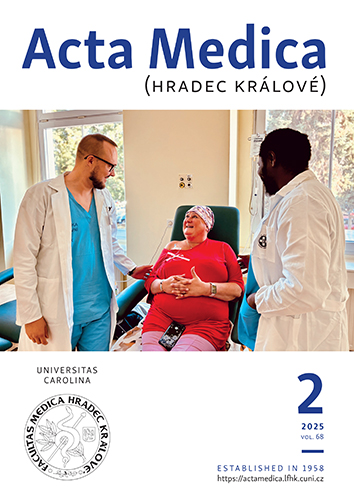ACTA MEDICA, Vol 60 No 1 (2017), 12–18
The Osteogenic Potential of Human Non-differentiated and Pre-differentiated Mesenchymal Stem Cells Combined with an Osteoconductive Scaffold – Early Stage Healing
Luboš Tuček, Zuzana Kočí, Kristýna Kárová, Helena Doležalová, Jakub Suchánek
DOI: https://doi.org/10.14712/18059694.2017.43
published online: 14. 06. 2017
abstract
Despite the huge research into stem cells and their regenerative properties for bone healing, there are still unanswered questions including the recipient’s respond to the presence of the stem cells, the fate of stem cells inside the bone defect and the possible advantage in utilizing pre-differentiated cells. To address these problems, we used human multipotent mesenchymal stromal/stem cells (MSCs), GMP Grade, in a rat model of bone formation. In a “bioreactor concept” approach seven Wistar rats were implanted with 0.2 g of synthetic bone scaffold seeded with 2 × 106 MSCs, seven Wistar rats were implanted with 0.2 g of synthetic bone scaffold seeded with 1 × 106 predifferentiated osteoblasts and 1 × 106 pre-differentiated endothelial cells and 14 Wistar rats were implanted with 0.2 g of synthetic bone scaffold without seeded cells into an intramuscular pocket on the left side of their back. The right side of each rat was used as a control, and 0.2 g of synthetic bone scaffold was implanted into the intramuscular pocket alone. To see the early stage healing the samples were harvested 14 days after the implantation, MSCs were detected by positive DAPI and MTCO2 staining in 43% of all the samples implanted with MSCs, and no inflammation signs were present in any implanted animal. New vessels could be found in both groups implanted with MSCs, but not in the control group of animals. However, hematoxylin-eosin staining could not detect newly created bone within the implant in any of the groups. These results were in line with COLL1 staining, where we could detect positive staining only in three cases, all of which were implanted with un-differentiated MSCs. According to our findings, there were no benefits of using the pre-differentiated of MSC.
keywords: mesenchymal stromal/stem cells; bone defect; osteoconduction; osteoinduction; scaffold; tissue bone engineering

The Osteogenic Potential of Human Non-differentiated and Pre-differentiated Mesenchymal Stem Cells Combined with an Osteoconductive Scaffold – Early Stage Healing is licensed under a Creative Commons Attribution 4.0 International License.
210 x 297 mm
periodicity: 4 x per year
print price: 150 czk
ISSN: 1211-4286
E-ISSN: 1805-9694
